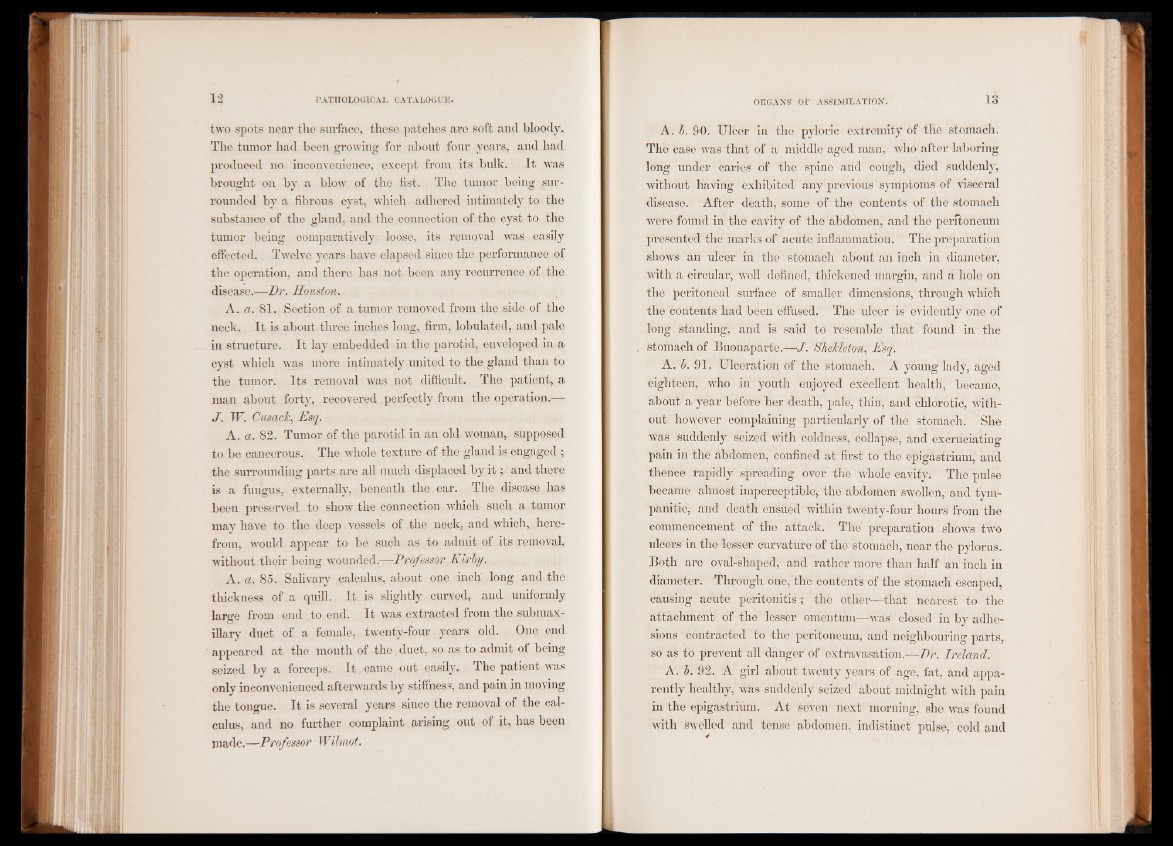
two spots near the surface, these patches are soft and bloody.
The tumor had been growing for about four years, and had
produced no inconvenience, except from its bulk. It was
brought on by a blow of the fist. The tumor being surrounded
by a fibrous cyst, which adhered intimately to the
substance of the gland, and the connection of the cyst to the
tumor being comparatively, loose, its removal was easily
effected. Twelve years have elapsed since the performance of
the operation, and there has not been any recurrence of the
disease.—Dr. Houston.
A. a. 81. Section of a tumor removed from the side of the
neck. It is about three inches long, firm, lobulated, and pale
in structure. It lay embedded in the parotid, enveloped in a
cyst which was more intimately united to the gland than to
the tumor. Its removal was not difficult. The patient, a
man about forty, recovered perfectly from the operation.^
J. W. Cusack, Esq.
A. a. 82. Tumor of the parotid in an old woman, supposed
to be cancerous. The whole texture of the gland is engaged ;
the surrounding parts are all much displaced by it; and there
is a fungus, externally, beneath the ear. The disease has
been preserved to show the connection which such a tumor
may have to the deep vessels of the neck, and which, herefrom,
would appear to be such as to admit of its removal,
without their being wounded .-^—Professor Kirby.
A. a. 85. Salivary calculus, about one inch long and the
thickness of a quill. It is slightly curved, and uniformly
large from end to end. It was extracted from the submax-
illary duct of a female, twenty-four years old. One end
appeared at the mouth of the duct, so as to admit of being
seized by a forceps. It came out easily. The patient was
only inconvenienced afterwards by stiffness, and pain in moving
the tongue. It is several years since the removal of the calculus,
and no further complaint arising out of it, has been
made.“ Professor Wilniot.
A. 1. .90. Ulcer in the pyloric extremity of the stomach.
The case was that of a middle aged man, who after laboring
long under caries of the spine and cough, died suddenly,
without having exhibited any previous symptoms of visceral
disease. After death, some of the contents of the stomach
were found in the cavity of the abdomen, and the peritoneum
presented the marks of acute inflammation. The preparation
shows an ulcer in the stomach about an inch in diameter,
with a circular, well defined, thickened margin, and a hole on
the peritoneal surface of smaller dimensions, through which
the contents had been effused. The ulcer is evidently one of
long standing, and is said to resemble' that found in the
stomach of Buonaparte.—J. SheJcleton, Esq.
A. b. 91. Ulceration of the stomach. A young lady, aged
eighteen, who in youth enjoyed excellent health, became,
about a year before her death, pale, thin, and chlorotic, without
however complaining particularly of the stomach. She
was suddenly seized with coldness, collapse, and excruciating
pain in the abdomen, confined at first to the epigastrium, and
thence rapidly spreading over the whole cavity. The pulse
became almost imperceptible, the abdomen swollen, and tympanitic,
and death ensued within twenty-four hours from the
commencement of the attack. The preparation shows two
ulcers in the lesser curvature of the stomach, near the pylorus.
Both are oval-shaped, and rather more than half an inch in
diameter. Through one, the contents of the stomach escaped,
causing acute peritonitis; the other—that nearest to the
attachment of the lesser omentum—w-as closed in by adhesions
contracted to the peritoneum, and neighbouring parts,
so as to prevent all danger of extravasation,—Dr. Ireland.
A. b. 92. A girl about twenty years of age, fat, and apparently
healthy, was suddenly seized about midnight with pain
in the epigastrium. At seven next morning, she was found
with Swelled and tense abdomen, indistinct pulse, cold and